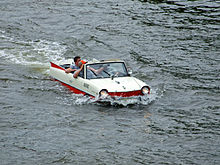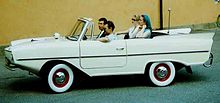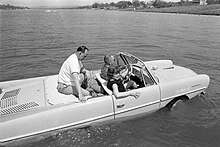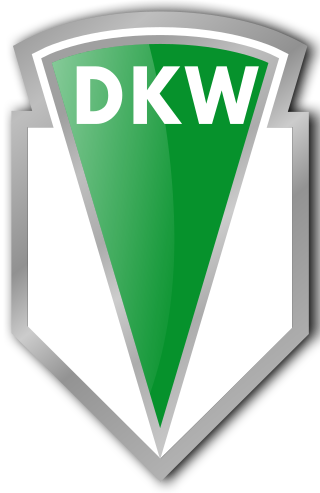
DKW was a German car- and motorcycle-marque. DKW was one of the four companies that formed Auto Union in 1932 and thus became an ancestor of the modern-day Audi company.

The Mini is a small, two-door, four-seat car, developed as ADO15, and produced by the British Motor Corporation (BMC) and its successors, from 1959 until 2000. Minus a brief hiatus, original Minis were built for four decades and sold during five, from the last year of the 1950s into the last year of the 20th century, over a single generation, as fastbacks, estates, and convertibles.

The Volkswagen Schwimmwagen is a light four-wheel drive amphibious car, used extensively by German ground forces during the Second World War. With over 15,000 units built, the Schwimmwagen is the most-produced amphibious car in history.

The Triumph Stag is a 2+2 sports tourer which was sold between 1970 and 1978 by the British Triumph Motor Company, styled by Italian designer Giovanni Michelotti.

NSU Motorenwerke AG, or NSU, was a German manufacturer of automobiles, motorcycles and pedal cycles, founded in 1873. Acquired by Volkswagen Group in 1969, VW merged NSU with Auto Union, creating Audi NSU Auto Union AG, ultimately Audi. The name NSU originated as an abbreviation of "Neckarsulm", the city where NSU was located.
Economy car is a term mostly used in the United States for cars designed for low-cost purchase and operation. Typical economy cars are small, lightweight, and inexpensive to both produce and purchase. Stringent design constraints generally force economy car manufacturers to be inventive. Many innovations in automobile design were originally developed for economy cars, such as the Ford Model T and the Austin Mini.

The Triumph TR4 is a sports car produced by the Triumph Motor Company from 1961 to 1965. Successor to the TR3A, the TR4's chassis and drivetrain are closely related to those of its predecessor, but with an updated body designed by Michelotti.
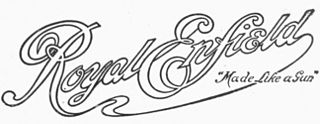
Royal Enfield was a brand name under which The Enfield Cycle Company Limited of Redditch, Worcestershire, England, sold motorcycles, bicycles, lawnmowers and stationary engines which it manufactured. Enfield Cycle Company also used the brand name "Enfield" without the "Royal".

The Triumph Spitfire is a British sports car manufactured over five production iterations between 1962 and 1980. Styled for Standard-Triumph in 1957 by Italian designer Giovanni Michelotti, the Spitfire was introduced at the London Motor Show in 1962. It was manufactured at the Standard-Triumph Canley works, with approximately 315,000 produced over 18 years.

The Triumph 1300 is a medium/small 4-door saloon car that was made between 1965 and 1970 by Standard Triumph in Coventry, England, under the control of Leyland Motors. It was introduced at the London Motor Show in October 1965 and intended as a replacement for the popular Triumph Herald. Its body was designed by Michelotti in a style similar to the larger Triumph 2000. It was replaced by the Triumph 1500, though it was also re-engineered in the early 1970s to provide the basis for the Toledo and Dolomite ranges.

The Datsun Sports, was a series of roadsters produced by Nissan in the 1960s. The series was a predecessor to the Z-car in the Fairlady line, and offered a competitor to the European MG, Triumph, Fiat and Alfa Romeo sports cars. Beginning with the 1959 S211, the line was built in two generations: the first generation was largely handbuilt in small numbers, while the second generation was series produced. The second generation first appeared in 1961 and continued through 1970 with the SP311 and SR311 lines.

The Triumph Herald is a small two-door car introduced by Standard-Triumph of Coventry in 1959 and made through to 1971. The body design was by the Italian stylist Giovanni Michelotti, and the car was offered in saloon, convertible, coupé, estate and van models, with the latter marketed as the Triumph Courier.

The Honda S600 is an automobile manufactured by Honda. It was launched in March 1964. Available as a roadster – bearing strong resemblance to the Honda S500 – and as a fastback coupé – introduced in March 1965 – the S600 was the first Honda available in two trim levels. During its production run up to 1966, the model styling would remain pretty much the same, with the most notable changes coming to the front grille, bumper, and headlights.

The Fiat 600 is a small, rear-engined city car and economy family car, made by Italian carmaker Fiat from 1955 to 1969 — offered in two-door fastback sedan and four-door Multipla mini MPV body styles. The 600 is considered a pop icon of the Italian economic miracle, and the three-row seating Multipla, though diminutive and odd-looking, is seen as one the first mass-produced minivans.

The Volkswagen Country Buggy is a small utility vehicle designed and built by Volkswagen in Australia. It used parts from the existing Type 1 and Type 2. Production ran from 1967 to 1968. A derivative of the Country Buggy called the Sakbayan was built in the Philippines for several years until 1980.

Ariel Motorcycles was a British maker of bicycles and then motorcycles in Bournbrook, Birmingham. It was an innovator in British motorcycling, part of the Ariel marque. The company was sold to BSA in 1951 but the brand survived until 1967. Influential Ariel designers included Val Page and Edward Turner. The last motorcycle-type vehicle to carry the Ariel name was a short-lived three-wheel tilting moped in 1970.
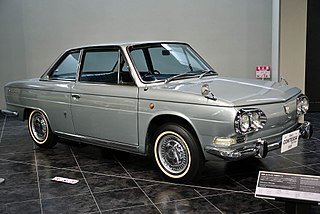
The Hino Contessa is an automobile which was produced by Hino Motors from 1961 to 1967.

An amphibious automobile is an automobile that is a means of transport viable on land as well as on or under water. They are unarmored for civilian use.
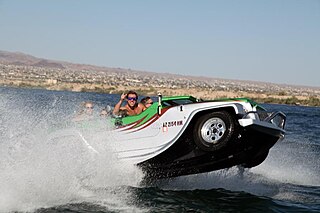
WaterCar is an American company that specializes in the manufacture and development of luxury amphibious vehicles. Based in Southern California, the company was founded by Dave March in 1999 when he was inspired by the Amphicar of the 1960s. March claims he originally had no plans to market an amphibious vehicle — just merely to build one. In 2013, the company released its first commercial vehicle, the Panther, which holds a top speed of 80 mph (130 km/h) on land and 45 mph (72 km/h) on water. The company holds 27 amphibious related patents as well as the Guinness World Record for the fastest amphibious vehicle. WaterCar vehicles are designed and manufactured at Fountain Valley BodyWorks, an 85,000 square feet (7,900 m2) collision repair auto body shop in Southern California, owned and operated by March.
Jacques Durand was a French engineer, model builder and automobile designer. He is primarily known for designing several sports cars, which were built in small volumes in France beginning in the 1950s and continuing into the 1990s.

